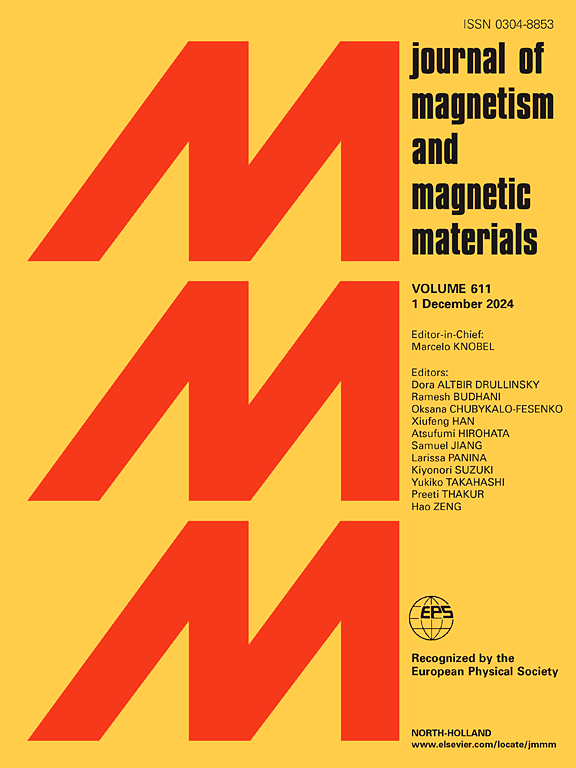具有单轴各向异性的球形磁性纳米颗粒混合型模拟技术的提出:布朗动力学和蒙特卡罗方法的结合实现了快速和可扩展的模拟
IF 2.5
3区 材料科学
Q3 MATERIALS SCIENCE, MULTIDISCIPLINARY
引用次数: 0
摘要
提出了一种结合布朗动力学(BD)和蒙特卡罗(MC)方法的单轴磁各向异性球形磁颗粒混合模拟方法。在这种混合型模拟方法中,采用BD方法模拟磁性粒子的粘性平移和旋转运动,其中用MC方法代替随机Landau-Lifshitz-Gilbert (LLG)方法确定磁性粒子的磁矩方向。我们研究了一个单粒子系统,以研究粒子和磁矩的取向特性。为了验证混合型方法的有效性,将所得结果与求解随机LLG方程所得结果进行了比较。对于磁化曲线,混合型模拟方法与随机LLG模拟方法一样,得到一个理论解(Langevin函数)。粒子的取向特性和磁矩作为磁各向异性值和磁场强度的函数,在两种模拟方法中得到了很好的一致性。即使各向异性因素比热运动更占主导地位,磁粒子在足够强的磁场中表现为超顺磁粒子。与随机LLG方法相比,所开发的混合型仿真方法在CPU时间方面提供了显着更高的性能,这是目前仿真方法中最吸引人的方面。这个CPU时间可能是决定多粒子系统基于粒子模拟方法可行性的决定性因素。我们的结论是,目前的混合型模拟方法是非常有效和实用的多粒子系统的模拟,其中粒子的运动和磁矩是控制因素,例如,在研究磁热疗。本文章由计算机程序翻译,如有差异,请以英文原文为准。
Proposal of hybrid-type simulation techniques for spherical magnetic nanoparticles with uniaxial anisotropy: A combination of Brownian dynamics and Monte Carlo methods achieving fast and scalable simulations
We developed a hybrid-type simulation method that combines the Brownian dynamics (BD) and Monte Carlo (MC) methods for spherical magnetic particles with uniaxial magnetic anisotropy. In this hybrid-type simulation method, the viscous translational and rotational motions of a magnetic particle are simulated using the BD method, where the direction of the magnetic moment of the particle is determined using the MC method instead of the stochastic Landau–Lifshitz–Gilbert (LLG) method. We addressed a single-particle system to investigate the orientational properties of both the particle and magnetic moment. In order to verify the validity of the hybrid-type method, the present results were compared with those obtained by solving a stochastic LLG equation. With respect to the magnetisation curve, the hybrid-type simulation method gives rise to a theoretical solution (Langevin function), just as in the stochastic LLG simulation method. The orientational characteristics of the particle and the magnetic moment, as a function of the value of the magnetic anisotropy and as a function of the magnetic field strength, agreed well between the two simulation methods. Even if the anisotropic factor is more dominant than the thermal motion, the magnetic particle behaves as a superparamagnetic particle in a sufficiently strong magnetic field. The developed hybrid-type simulation method provides significantly higher performance with respect to CPU time in comparison with the stochastic LLG method, which is the most appealing aspect of the present simulation method. This CPU time may be a definitive factor in determining the feasibility of a particle-based simulation method for a multi-particle system. We conclude that the present hybrid-type simulation method is remarkably effective and practical for simulations of a multi-particle system where the motion of both the particle and the magnetic moment are governing factors, for instance, in studies on magnetic hyperthermia.
求助全文
通过发布文献求助,成功后即可免费获取论文全文。
去求助
来源期刊

Journal of Magnetism and Magnetic Materials
物理-材料科学:综合
CiteScore
5.30
自引率
11.10%
发文量
1149
审稿时长
59 days
期刊介绍:
The Journal of Magnetism and Magnetic Materials provides an important forum for the disclosure and discussion of original contributions covering the whole spectrum of topics, from basic magnetism to the technology and applications of magnetic materials. The journal encourages greater interaction between the basic and applied sub-disciplines of magnetism with comprehensive review articles, in addition to full-length contributions. In addition, other categories of contributions are welcome, including Critical Focused issues, Current Perspectives and Outreach to the General Public.
Main Categories:
Full-length articles:
Technically original research documents that report results of value to the communities that comprise the journal audience. The link between chemical, structural and microstructural properties on the one hand and magnetic properties on the other hand are encouraged.
In addition to general topics covering all areas of magnetism and magnetic materials, the full-length articles also include three sub-sections, focusing on Nanomagnetism, Spintronics and Applications.
The sub-section on Nanomagnetism contains articles on magnetic nanoparticles, nanowires, thin films, 2D materials and other nanoscale magnetic materials and their applications.
The sub-section on Spintronics contains articles on magnetoresistance, magnetoimpedance, magneto-optical phenomena, Micro-Electro-Mechanical Systems (MEMS), and other topics related to spin current control and magneto-transport phenomena. The sub-section on Applications display papers that focus on applications of magnetic materials. The applications need to show a connection to magnetism.
Review articles:
Review articles organize, clarify, and summarize existing major works in the areas covered by the Journal and provide comprehensive citations to the full spectrum of relevant literature.
 求助内容:
求助内容: 应助结果提醒方式:
应助结果提醒方式:


